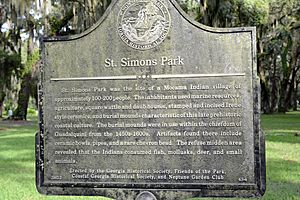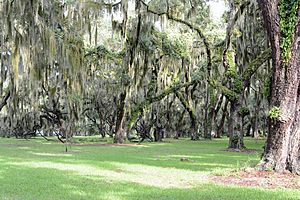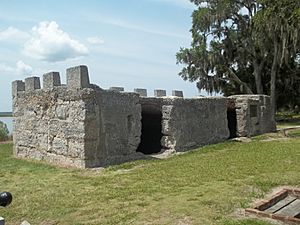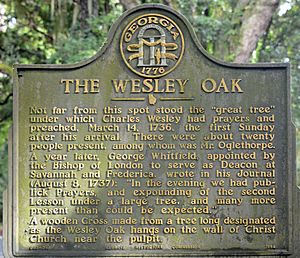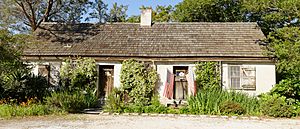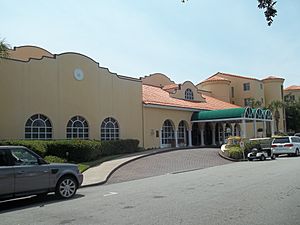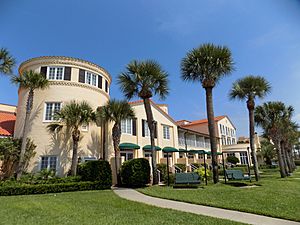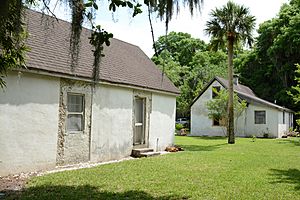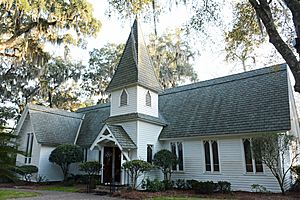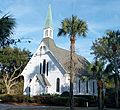St. Simons, Georgia facts for kids
Quick facts for kids
St. Simons Island, Georgia
|
|
|---|---|
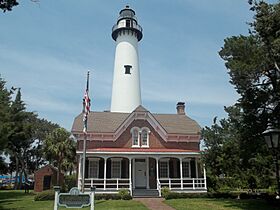
|
|
| Country | United States |
| State | Georgia |
| County | Glynn |
| Area | |
| • Total | 17.51 sq mi (45.34 km2) |
| • Land | 16.48 sq mi (42.69 km2) |
| • Water | 1.02 sq mi (2.65 km2) |
| Elevation | 10 ft (3 m) |
| Population
(2020)
|
|
| • Total | 14,982 |
| • Density | 908.94/sq mi (350.95/km2) |
| Time zone | UTC−5 (Eastern (EST)) |
| • Summer (DST) | UTC−4 (EDT) |
| Zip Code |
31522
|
| Area code(s) | 912 |
| FIPS code | 13-68040 |
| GNIS feature ID | 0322308 |
St. Simons Island is a beautiful barrier island located in Glynn County, Georgia, United States. People often call it "St. Simons" or "The Island." It is part of the Brunswick metropolitan area. In 2020, about 14,982 people lived here.
St. Simons Island is on the southeast coast of Georgia. It is located between Savannah and Jacksonville. The island is a popular seaside resort and a place where people live all year. It is the largest of Georgia's famous Golden Isles. The other Golden Isles include Sea Island, Jekyll Island, and Little St. Simons Island.
Many people visit St. Simons Island for its warm weather and lovely beaches. They also enjoy outdoor activities, shops, restaurants, and historical sites. The island's natural beauty is a big draw.
Besides permanent residents, many visitors and part-time residents come throughout the year. Most of the shops and homes are on the southern part of the island. The northern part is mostly marsh or woodland. A large area in the northeast is a nature preserve. It has trails, old ruins, and a natural forest. This area, called Cannon's Point Preserve, is open to the public on certain days.
The Muscogee people first lived on the island. Later, Spain, Britain, and France all wanted control of this area. After the Province of Georgia was started in 1732, British colonists built rice and cotton plantations. People who were enslaved worked on these plantations. They created a special culture called Gullah, which still exists today. You can get to the island by car using the F.J. Torras Causeway. Malcolm McKinnon Airport (IATA: SSI) is also on the island for smaller planes.
Contents
- Island History: From Ancient Times to Today
- Island Geography and Climate
- Island Economy and Tourism
- Arts, Culture, and Heritage
- Sports and Activities on the Island
- Places to Visit on St. Simons Island
- A. W. Jones Heritage Center
- Arthur J. Moore Methodist Museum and Library
- Avenue of the Oaks
- Bloody Marsh Battle Site
- Cassina Garden Club Tabby Slave Cabins
- Christ Church
- Epworth By The Sea
- Fort Frederica National Monument
- Gascoigne Bluff
- Lovely Lane Chapel
- World War II Home Front Museum
- St. Simons Island Lighthouse Museum
- Education on St. Simons Island
- Famous People from St. Simons Island
- See also
Island History: From Ancient Times to Today
Early Inhabitants and European Arrival
Just north of the village on St. Simons Island is a park with oak trees called St. Simons Park. There is a small mound where 30 Timucua Native Americans are buried. These people lived in a settlement here two centuries before Europeans arrived.
Cannon's Point, on the north end of St. Simon's Island, is an important archaeological site. It shows that Native Americans lived there a very long time ago. They left behind shell rings and pottery. Different groups lived on the island over time. These included the Sapelo, Refuge, Deptford, Wilmington, St. Catherine's, Savannah, Pine Harbor, and Sutherland Bluff peoples.
Many experts in the early 1900s thought the people of St. Simons Island were Guale. However, other evidence suggests they were part of the Mocama people. It's possible that the Guale lived there first. Then, after a rebellion in 1597, the Timucua-speaking Mocama people moved to the island.
Spanish Missions and Conflicts
The Spanish built a mission called San Buenaventura de Guadalquini on the southern end of St. Simons Island. This happened between 1597 and 1609, likely near where the St. Simons Island Light is now. The Timucua name for the island was Guadalquini. The Spanish called it Isla de Ballenas, meaning "Isle of Whales."
In 1680, raiders attacked a village of Yamasee people on St. Simon Island. These raiders were helped by the English from the Province of Carolina. Spanish soldiers and Native Americans from San Buenaventura helped the village, making the raiders leave.
In 1683, pirates attacked St. Augustine. In 1684, Native American allies of the English attacked missions along the Georgia coast. The San Buenaventura mission was told to move south. Before they could move, pirates returned in 1684. The chief, Lorenzo de Santiago, moved his people and their belongings to the mainland. When the pirates landed, they found only a few men guarding the village. The pirates burned the village and the mission. After this, the people of Guadalquini moved to a new mission called Santa Cruz de Guadalquini.
Fort Frederica: A British Stronghold
Fort Frederica was built starting in 1736. It was the main military base for the Province of Georgia. Its purpose was to protect the area from Spanish attacks from Florida.
Near the fort, two important battles took place on July 7, 1742. These were the Battle of Gully Hole Creek and the Battle of Bloody Marsh. The British soldiers surprised Spanish troops marching through the marsh. The British won, stopping Spain from invading Georgia during the War of Jenkins' Ear.
In the 1900s, a resident named Margaret Davis Cates helped save Fort Frederica. She raised money to buy the land and start preserving it. In 1947, it became a National Monument.
The Wesley Brothers and Methodism
In the 1730s, John Wesley, a young minister, lived on St. Simons Island sometimes. He later founded the Methodism movement in England. John Wesley and his brother Charles Wesley both did missionary work on St. Simons. They tried to convert people to Christianity.
Later, in the late 1700s, Methodist preachers traveled through Georgia. This was part of the Great Awakening, a religious movement. Many enslaved African-Americans in Georgia became Christians during this time.
In 1987, a new church was started on the north end of St. Simons Island. It was named Wesley United Methodist Church at Frederica. This was where John and Charles Wesley had preached many years ago.
American Revolution on the Coast
In 1778, Colonel Samuel Elbert led Georgia's Continental Army and Navy. On April 15, he learned that four British ships were in St. Simons Sound. Elbert's troops marched to Darien, Georgia. There, they boarded three Georgia Navy ships called galleys.
On April 19, the galleys attacked the British ships. The Colonial ships had stronger cannons. Also, the galleys could be rowed and had a shallow draft, making them easy to move in the river. When the wind stopped, the British ships had trouble moving. Two British ships got stuck, and their crews escaped. This battle, called the Frederica Naval Action, showed how effective the galleys were. It also boosted the spirits of the colonists in Georgia.
Cotton Plantations and Enslaved People
During the plantation era, St. Simons became a major center for cotton production. The island was known for its special long-fiber Sea Island Cotton. Almost all the trees were cleared to make room for large cotton plantations. People who were enslaved, known as Geechee people, worked on these plantations.
These plantations were very large. Often, the owners lived on the mainland, especially in the summers. This was because the island was thought to be unhealthy due to diseases. However, the enslaved Geechee people lived on the island. They were not allowed to go to the mainland without an owner. One original slave cabin, built of tabby (a mix of lime, sand, water, and oyster shells), still stands today.
Civil War and Its Aftermath
At the start of the American Civil War, Confederate troops were on St. Simons Island. They protected its important location near Brunswick harbor. But in 1862, Robert E. Lee ordered them to leave. They moved the soldiers to defend Savannah, Georgia. Before leaving, they destroyed the lighthouse so the U.S. Navy could not use it. The U.S. Army then occupied the island for the rest of the war.
After the war, the island's plantations were ruined. It was too expensive for landowners to grow cotton or rice. Most moved away. The island's economy was quiet for several years. People who had been enslaved started a community called Harrington in the center of the island.
Growth and Tourism Since the 1800s
St. Simons Island first exported lumber in the late 1700s. Wood from 2,000 Southern live oak trees from Gascoigne Bluff was used to build the USS Constitution and other ships. The USS Constitution is famous as "Old Ironsides" because cannonballs bounced off its strong oak wood.
More lumber production started in the late 1870s. Mills were built near Gascoigne Bluff. Lumber from St. Simons was even sent to New York City to help build the Brooklyn Bridge.
After the lumber industry declined, tourism began to grow. In the 1870s, summer cottages were built on the island's south end. A small village grew to serve these visitors. A pier built in 1887 brought more visitors by boat. Hotels like the Hotel St. Simons opened. When cars became popular and the Torras Causeway opened in 1924, tourism really took off. St. Simons became the only one of the Golden Isles that was not privately owned. New hotels and roads were built, making tourism the main part of the island's economy.
During World War II, on April 8, 1942, a German U-boat sank two oil tankers near St. Simons Island. The explosions broke windows in Brunswick. People worried about German soldiers landing on the beaches. Security was increased, and anti-submarine patrols stopped the U-boat threat. McKinnon Airport became a Naval Air Station. The King and Prince Hotel, built in 1941, was used for training. It is now on the U.S. National Register of Historic Places.
After the war, more people started living on St. Simons Island year-round. The population grew from 1,706 in 1950 to 13,381 by 2000.
Island Geography and Climate
| Weather chart for St. Simons Island | |||||||||||||||||||||||||||||||||||||||||||||||
|---|---|---|---|---|---|---|---|---|---|---|---|---|---|---|---|---|---|---|---|---|---|---|---|---|---|---|---|---|---|---|---|---|---|---|---|---|---|---|---|---|---|---|---|---|---|---|---|
| J | F | M | A | M | J | J | A | S | O | N | D | ||||||||||||||||||||||||||||||||||||
|
3.2
61
43
|
3.5
63
46
|
3.9
69
52
|
2.5
75
58
|
1.9
82
67
|
4.8
88
73
|
4.1
90
75
|
6.3
89
75
|
5.8
85
72
|
4.5
78
63
|
2
70
53
|
2.6
63
45
|
||||||||||||||||||||||||||||||||||||
| temperatures in °F precipitation totals in inches source: NOAA |
|||||||||||||||||||||||||||||||||||||||||||||||
|
Metric conversion
|
|||||||||||||||||||||||||||||||||||||||||||||||
St. Simons Island is a barrier island with many marsh hammocks. It is located between the Altamaha River delta to the north and St. Simons Sound to the south. Sea Island is to the east, and Little St. Simons is to the north. The marshes of Glynn and the Intracoastal Waterway are to the west.
The island is about 12 miles (19 km) east of Brunswick, Georgia. Brunswick is the main city and county seat of Glynn County.
Weather and Seasons
St. Simons Island has a humid subtropical climate. Ocean breezes make the island's weather milder than the nearby mainland. In winter, daytime highs are usually between 61 and 68°F (16-20°C). Nighttime lows average 43 to 52°F (6-11°C). In summer, daytime highs are 88 to 90°F (31-32°C). Average lows are 73 to 75°F (23-24°C).
The island gets about 45 inches (114 cm) of rain each year. August and September have the most rain, with afternoon thunderstorms. Snow and ice are very rare. The last time it snowed on St. Simons was in 1989.
The island covers about 17.7 square miles (45.8 km2). About 15.9 square miles (41.2 km2) is land, and 1.7 square miles (4.4 km2) is water.
Nature and Wildlife
St. Simons Island has a rich and varied ecology. It has sandy beaches, marshes, and maritime forests. Even with farming and building over the years, many live oaks and other trees covered in Spanish moss still shade the island. The marshes, estuaries, and plants provide lots of food. This attracts many different animals on land, in the sea, and in the air.
You might see white-tailed deer, marsh rabbits, raccoons, alligators, and armadillos. Many shorebirds live here or visit, like sandpipers, plovers, herons, egrets, and brown pelicans. The southern bald eagle can also be seen.
The area around St. Simons Island is a key stop for migrating shorebirds. They travel between South America and the Canadian arctic. Because of this, Gould's Inlet and East Beach are part of the Colonial Coast Birding Trail.
The waters around St. Simons Island are full of sea life. You can find dolphins, right whales, many types of gamefish, and sometimes even a manatee. In late spring and summer, loggerhead sea turtles come to the beach to lay their eggs. Naturalists watch and protect these nests.
The island's beaches are always changing due to tides, wind, and storms. On the beach, you might see ghost crabs, sand dollars, horseshoe crabs, and hermit crabs in conch shells. Sea oats and morning glories grow on the dunes. You can often see Dolphins off the south coast.
Cannon's Point Preserve
In 2012, the St. Simons Land Trust bought 608 acres of undeveloped land. This area is in the northeast part of the island. It includes maritime forest, salt marsh, tidal creeks, and river shoreline. It also has ancient shell middens and ruins from a 19th-century plantation.
The Preserve is open to the public on Saturdays, Sundays, and Mondays from 9 AM to 3 PM. You can go hiking, bicycling, bird-watching, and picnicking. There is also a place to launch kayaks, canoes, and paddleboards. An observation tower is at the north end.
Island Economy and Tourism
Tourism is the main way St. Simons Island makes money. Important industries include hotels, restaurants, shops, and other services. The biggest employers are the Sea Island Company, King & Prince Resort, and Rich Products.
Visitors have come to St. Simons Island since the late 1800s. They first arrived by boat at the pier. Later, they came by car using the F. J. Torras Causeway. The McKinnon St. Simons Island Airport opened in 1938 for smaller planes. People flying commercially arrive at the nearby Brunswick Golden Isles Airport (BQK). There are also three marinas for boats.
Today, St. Simons Island is promoted as one of Georgia's "Golden Isles." People visit all year, but especially in spring and summer. You can stay in hotels, rental homes, or condos. Taxis and car rentals are available, including golf carts. You can also rent bicycles.
People visit St. Simons Island for its beaches, views, water sports, fishing, and golf. They also enjoy historical sites and the relaxed island life. The PGA Tour's RSM Classic golf tournament is held here every November. In 2013, the Sea Island Golf Club was named one of America's top 50 golf courses for women.
Nature lovers come to enjoy the environment, watch birds, and visit Cannon's Point Preserve. Hiking and bicycling are popular all year. St. Simons Island is also a favorite spot for photographers and painters. Its beautiful and historic places, like the St. Simons Lighthouse and Christ Church, make it a popular place for weddings.
Many travel guides and websites have recommended St. Simons Island. These include Condé Nast Traveler, Travel+Leisure, Smithsonian Magazine, and TripAdvisor.
Arts, Culture, and Heritage
Many artists live on or visit St. Simons Island. Painters and photographers capture the beautiful scenery. Their work is shown in several island galleries. Glynn Visual Arts helps local artists with exhibits, festivals, and classes. These include painting, drawing, pottery, photography, and jewelry. The Literary Guild of St. Simons Island supports writers with events. The Island Players, a theater group, performs at the Pier Village Casino Theatre. Craft shows are held often in Postell Park.
St. Simons Island has a lively music scene. Local bands and musicians perform at various places. There are summer concerts by the lighthouse and classical music concerts.
Novelist Eugenia Price visited St. Simons Island in 1961. She loved the island so much that she researched its history. This led to her writing three novels known as the "St. Simons Trilogy." She lived on the island from 1965 until she passed away in 1996.
Part of the film Conrack (1974) was filmed on St. Simons Island.
African American Heritage
After the American Civil War, many Geechee people who had been enslaved stayed on St. Simons Island. They grew food and fished to survive. Many later found jobs at the lumber mills in the 1870s. They attended the First African Baptist Church, which was finished in 1869 by formerly enslaved people. Services are still held there today.
In 2000, a group formed the St. Simons African American Heritage Coalition. They work to protect the history of African-Americans on the island. The coalition offers tours of historic sites. They also hold the annual Georgia Sea Islands Festival. This festival celebrates traditional Geechee African-American music, food, and crafts. The coalition is also working to restore the historic Harrington School House. This school was built in the 1920s for African-American children on the island.
Sports and Activities on the Island
The weather on St. Simons Island is great for outdoor sports and activities all year. Golf is very popular, with seven golf courses on the island. Public tennis courts are at Epworth Park and Mallery Park. These courts also have lines for pickleball. Several resorts on the island also have tennis courts.
There are eight public parks on the island. They have picnic tables, sports fields, and playgrounds. Demere Park has a skate park. Gascoigne Park offers a disc golf course and a waterfront picnic area. The Neptune Park Fun Zone, near the Pier Village, has a public swimming pool, miniature golf, and playgrounds. The St. Simons Casino Building next door hosts events and the St. Simons Library.
You can access the beach at many points along the Atlantic shore. The most popular spots are Coast Guard Beach and Massengale Park. Both have restrooms and easy beach access for everyone. Massengale Park also has picnic tables and a playground.
Hikers, walkers, and bikers can enjoy the St. Simons Island-wide Trail System. It goes from the Village area to East Beach and Hampton Point. Other trails include the Alice Richards Botanical Trail in Frederica Park and the John Gilbert Nature Trail. Cannon's Point Preserve also has trails. Other outdoor activities include kayaking, paddleboarding, and horseback riding. You can also go boating and sailing.
Neptune Park: A Special Place
Neptune Park includes the Neptune Park Fun Zone. It is in the "village" area, right next to the pier. The park is named after Neptune Small. He was an enslaved man who worked for Henry King, a plantation owner. King fought in the American Civil War. When King was killed in battle, Neptune Small bravely went to find his body. He brought King's body all the way back to St. Simons for burial. The King family later gave Neptune Small 8 acres of their land. Part of this land is now Neptune Park.
Places to Visit on St. Simons Island
A. W. Jones Heritage Center
The A.W. Jones Heritage Center opened in 2008. It is the main building for the Coastal Georgia Historical Society. The center has exhibits, a gift shop, and a large event hall. It also has a research library and a huge collection of historical items from coastal Georgia.
Arthur J. Moore Methodist Museum and Library
This museum and library opened in 1966. It is located at Epworth by the Sea. It holds books and historical items about St. Simons Island's early days. It also has items related to John and Charles Wesley, who started the Methodist movement. They came to the island with James Oglethorpe. The museum is open to the public Monday through Saturday, and admission is free.
Avenue of the Oaks
In 1850, Anne Page King planted two rows of live oak trees. These trees formed the grand entrance to Retreat Plantation. Today, they are a beautiful sight at the entrance to the Sea Island Golf Club. You can drive by to see them.
Bloody Marsh Battle Site
At the Battle of Bloody Marsh on July 7, 1742, British soldiers defeated Spanish troops. This battle stopped Spain from claiming Georgia. Markers and information panels at this outdoor site explain the battle. It is managed by the National Park Service as part of Fort Frederica National Monument.
Cassina Garden Club Tabby Slave Cabins
Hamilton Plantation was a very successful cotton plantation on St. Simons Island. It was located on Gascoigne Bluff. Two of the original slave cabins still stand today. These cabins were built from tabby, a strong material made of lime, sand, water, and oyster shells. The Cassina Garden Club owns and operates these cabins. They are open to the public on Wednesdays in June, July, and August. You can also arrange private tours.
Christ Church
In 1808, Georgia gave 100 acres (40 ha) of land on St. Simons for an Episcopal church. This church, called Christ Church, was finished in 1820. During the Civil War, U.S. troops used the building for horses, and it was badly damaged. A lumber businessman, Anson Phelps Dodge, restored the church in 1884. His son became the first leader of the new church. Today, this historic church is home to an active church group. The cemetery next to it has graves from as far back as 1803.
Epworth By The Sea
Epworth By The Sea is a large conference and retreat center. It covers 100 acres (40 ha) and is owned by the United Methodist Church. The property has motels, apartments, cabins, and meeting rooms. It also has dining rooms and a preschool. There is a swimming pool, athletic field, basketball courts, tennis courts, and fishing piers. The Lovely Lane Chapel, built in 1880, holds Sunday services and weddings.
Fort Frederica National Monument
Fort Frederica was built in 1736 by British General James Oglethorpe. It protected the southern border of his Georgia colony. The site was both a fort and a small town. In 1742, soldiers from the fort defeated Spanish forces at the Battle of Bloody Marsh. This battle secured Georgia for the British. Later, the troops left, and the town fell apart. In 1945, Fort Frederica became a national monument. The National Park Service now manages it.
Gascoigne Bluff
Gascoigne Bluff has been important throughout St. Simons Island's history. Long ago, Native Americans lived and camped here. The Spanish also built a mission nearby. In 1736, General Oglethorpe and the British set up a naval base here. They named the area after Captain James Gascoigne. In 1794, lumber from the bluff was used to build the famous ship, "Old Ironsides." During the cotton farming era, it was the site of the Hamilton plantation. Two slave cabins from that time still stand. In the late 1800s, lumber mills thrived here. Today, Epworth By The Sea and Gascoigne Bluff Park are located here. The park has picnic tables, restrooms, and a fishing pier.
Lovely Lane Chapel
In 1880, Norman W. Dodge built St. James Union Church at Gascoigne Bluff for the lumber mill community. After the mills closed, the building became a social hall. When the Methodists bought the property in 1949, they renamed it Lovely Lane Chapel. The chapel is open for Sunday services and weddings.
World War II Home Front Museum
The Coastal Georgia Historical Society runs the World War II Home Front Museum. It is in the Historic St. Simons Coast Guard Station, built in 1936. On April 8, 1942, the crew from this station rescued survivors of two American ships. These ships were hit by a German U-boat near St. Simons Island. Visitors can learn about how ordinary Americans helped win the war.
St. Simons Island Lighthouse Museum
The first St. Simons Island Light, built in 1811, was destroyed by Confederate troops in 1861. They did not want the U.S. Navy to use it. It was rebuilt in 1872 and still works today. The Coastal Georgia Historical Society owns it, and the United States Coast Guard Auxiliary maintains it. The building next to it, where the lighthouse keeper lived, is now a museum. It has exhibits about the lighthouse and a restored keeper's home. Visitors can climb the 129 steps to the top for amazing views of the ocean and islands.
Education on St. Simons Island
St. Simons Island is part of the Glynn County School District. There are two public elementary schools on the island: Oglethorpe Point Elementary and St. Simons Elementary. They serve students from pre-kindergarten to 5th grade.
Students then attend:
- Glynn Middle School (GMS)
- Glynn Academy (GA)
Private schools on the island include:
- Frederica Academy – for grades PK-12
- St. Simons Christian School – for grades PK-8
Famous People from St. Simons Island
- Tina McElroy Ansa, a novelist and journalist.
- Griffin Bell, a former U.S. Attorney General.
- Iris Faircloth Blitch, a former United States Representative in Congress.
- Morgan Brian, a World Cup Champion and Olympian in the United States women's national soccer team.
- Alton Brown, a TV personality from Food Network.
- Jim Brown, a Hall of Fame NFL player and actor.
- Kwame Brown, a former NBA player.
- Jonathan Byrd, a professional golfer.
- Jack Davis, a famous cartoonist.
- William Diehl, an award-winning novelist.
- Brian Harman, a professional golfer.
- Sam Hunt, a country singer who lives here part-time.
- Anna Jay, a professional wrestler.
- Zach Johnson, a professional golfer.
- Bessie Jones, a gospel singer.
- Matt Kuchar, a professional golfer.
- Davis Love III, a professional golfer.
- Mack Mattingly, a former U.S. Senator.
- J. Reginald Murphy, a former editor of major newspapers and president of National Geographic Society.
- Sam Nunn, a former U.S. Senator.
- Eugenia Price, author of the St. Simons Trilogy.
- Bob Schieffer, an American television journalist.
- John Smoltz, a retired MLB pitcher, formerly with the Atlanta Braves.
- Adam Wainwright, a former MLB pitcher for the St. Louis Cardinals.
- Larry White, a business executive.
- Heather Whitestone, Miss America 1995, the first disabled Miss America.
See also
 In Spanish: St. Simons (Georgia) para niños
In Spanish: St. Simons (Georgia) para niños


